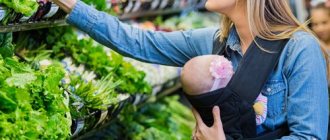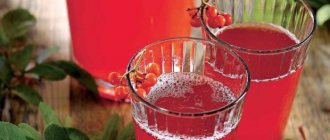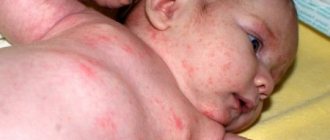Young children react very sensitively to unusual food, poor quality products and food poisons. Vomiting in a child is a protective mechanism that allows the stomach to be freed from dangerous substances. It can occur for various reasons and be one-time or long-term.
After providing the child with medical care, it is necessary to take care of an appropriate gentle diet, especially if the child has diarrhea and vomiting combined.
What to feed a convalescent person to support a weakened body and restore impaired digestion?
Why does a child often vomit?
Vomiting in a child can be caused by a number of different reasons. The less serious and harmful ones are:
- headbutt;
- consumption of “aggressive” products (with a lot of seasonings, spices, chemical additives, etc.);
- nervous stress;
- teething (read more about the symptoms of teething in babies);
- forced feeding.
For one of the above reasons, vomiting is usually one-time in nature. Much more serious causes of this unpleasant phenomenon can be considered:
- food poisoning;
- high temperature;
- diseases of the gastrointestinal tract;
- central nervous system disorders;
- renal or heart failure;
- infectious diseases, etc.
Is it possible to drink milk and eat milk if poisoned?
Despite the beneficial properties of a calcium-rich drink, during periods of intoxication it is better to refrain from drinking it for the following reasons:
- provokes gagging, flatulence, a feeling of discomfort, bloating,
- difficult to digest due to high fat content, which can lead to diarrhea and increased abdominal pain,
- drinking milk during poisoning increases the risk of developing an inflammatory process - feverish tremors, elevated body temperature, spasms of muscle tissue in the abdominal cavity, acute pain in the stomach,
- in case of poisoning caused by bacteria, the drink will create favorable conditions for the proliferation of dangerous microorganisms.
Milk can reduce the feeling of discomfort during poisoning. Considering the negative consequences of consuming a natural product, it is better to give preference to medications against heartburn.
Fermented milk products have a similar negative effect, like milk, on the body: fermented baked milk, ayran, kefir, sour cream and yoghurts. Adding drinks to the diet is allowed only during the recovery period and in the absence of individual intolerance.
What to feed while vomiting
Often during this unpleasant phenomenon the child has no appetite, so you should not insist on eating food. It is much more important during this period to ensure that the baby drinks enough. The best options for this are rosehip decoction, black or herbal tea, a weak water-salt solution, still mineral water, and dried fruit compote. Drinking plenty of fluids will help not only replenish the fluid lost by the child, but also cleanse the body of toxins and reduce body temperature if present.
If vomiting occurs in a baby who is breastfed, then you should not stop feeding him at all. Breast milk can also replenish the lack of fluid and improve digestion. The same applies to artificial babies.
Possible causes of baby vomiting
Vomiting occurs in children of any age: one year old, 5 years old, and schoolchildren. In no case should you give a baby of any age drugs that suppress nausea, since this condition is a protective reaction of the body that gets rid of toxins. Also, parents should definitely know what they can eat when their child is vomiting, and what foods are definitely prohibited.
It should be kept in mind that vomiting does not always indicate poisoning or a gastrointestinal infection. This condition may have completely different causes, for example:
- Traumatic brain injuries of varying severity (open closed), concussions, increased intracranial pressure, some neurological diseases. In this case, the treatment tactics are determined by a neurologist;
Banal overeating. This often happens if a child, left without parental supervision, has eaten a lot of fruit or sweets;- Heavy, high-calorie, fatty foods that put a lot of stress on the liver. In this case, vomiting is a protective reaction of the liver to overload. This condition goes away on its own after some time;
- Side effects of some medications. Many medications prescribed to children can cause vomiting. Before giving your baby any medicine, you must study the possible side effects so that there are no surprises later;
- Sometimes vomiting is a symptom of an allergic reaction, but more often it indicates an individual intolerance to a particular product.
Nausea is also common in children who are force-fed. Therefore, if your baby has a poor appetite, you should never force him to eat. It’s better to try to decorate the food beautifully, and then the child will definitely want to eat it.
Read also: What can you feed a child with diarrhea and the importance of diet for a baby
If the pediatrician believes that the baby is completely healthy, vomiting may be a reaction to severe psychological stress. In this case, parents must find out what exactly caused this stress and make sure that this situation does not recur in the future. This condition often occurs in nervous, anxious children during the period of adaptation to school and kindergarten, as well as after the divorce of their parents, the death of a close relative or a beloved pet.
Having found out the cause of vomiting, you can develop a suitable diet for your baby. In any case, the nutrition of such babies should be of very high quality, so that bad foods do not irritate the stomach, weakened by vomiting.
What to feed in the first days after vomiting
It is impossible to say exactly how long after an attack you should start feeding your child. In this case, you need to focus on the baby himself and start feeding him when his health improves a little, he has an appetite, and signs of hunger begin to appear (as a rule, this happens after 6 hours). The pediatrician can tell exactly what a child’s diet should look like after vomiting and how long the diet should last only after clearly establishing the cause of this unpleasant phenomenon.
However, in any case, you can feed your baby only easily digestible foods that are gentle on his stomach. Such products could be:
- porridge, for example: rice, buckwheat or oatmeal (it is better to start eating with them after this trouble);
- boiled vegetables (broccoli, carrots);
- baked apples;
- natural yogurt without specific additives or non-acidic kefir;
- bananas;
- wheat crackers or biscuits.
On the contrary, products that should be avoided at this time are:
- meat and fish;
- baked goods;
- sweets;
- raw vegetables and fruits;
- millet, pearl barley and barley porridge;
- sausages and smoked meats;
- sunflower and butter;
- mushrooms;
- fast food;
- potato;
- pasta, etc.
So, you can start giving meat and fish only on the 4th day after the incident, potatoes - on the 3rd, etc.
If an attack occurs in a baby, then parents should give up complementary feeding for 1-2 days and limit themselves to only breast milk or formula.
How to help a child recover?
In the first two weeks after vomiting, you need to carefully monitor your child's diet. To begin with, you should avoid products that contain dyes, preservatives and other chemicals - baked goods, sweets, juices, canned food, smoked foods, seasonings, etc. are not recommended.
It is worth limiting the amount of carbohydrates and fats. The child’s menu should include porridge, low-fat kefir, and yogurt. Be sure to include protein foods in your diet, in particular fish and chicken, but they need to be steamed. To restore the body, broths are suitable, to which you can add homemade noodles.
Gradually, familiar products can be introduced into the menu. But be careful - if vomiting was caused by poisoning with some foods, they should be carefully avoided.
Features of preparing food for a child after vomiting
You should be especially careful when preparing food for a child after such an unpleasant phenomenon as vomiting. Firstly, it is advisable to give the baby only fresh food at this time, so it must be prepared immediately before consumption. Also during this period it is necessary to give preference to boiling, stewing or steaming.
To make the process of assimilation of food as easy as possible for the baby’s exhausted body, it must be crushed (using a blender or sieve). At this time, it is preferable to cook porridge in water. It is also absolutely contraindicated to add any seasonings to food. We should not forget that too hot or cold food can further injure the walls of a child’s stomach, so you should feed your baby exclusively with warm foods.
Basic principles of nutrition for diarrhea
With diarrhea, the walls of the small and large intestines are inflamed, and the muscles contracting during spasms lead to too rapid movement of food masses. As a result, the patient does not have time to get enough nutrients from the food he eats. The body not only loses water, but also lacks the proteins, fats and carbohydrates it needs.
In addition, regular food contains fats, spices, coarse fiber and can irritate the intestinal wall, causing bloating, colic and pain. The patient’s condition can be alleviated with the help of a specially selected gentle diet. Features of the diet for diarrhea:
- Food should be easy to digest. This is necessary so that the nutrients have time to be absorbed during a shortened period of passage through the intestines.
- The patient should be given food with a puree consistency. Hard food takes longer to digest and injures sensitive mucous membranes.
- It is necessary to adhere to a gentle temperature. Food should not be hot or cold.
- Meals should be fractional and portions should be small in volume.
What foods can you eat?
Parents of a sick child are interested in the question: what to feed their child with diarrhea? A patient suffering from diarrhea loses a large amount of nutrients and water, so the diet should be selected in such a way that the body can extract as much benefit from the food eaten as possible. Professional nutritionists suggest that such patients use a specially developed standard diet. To make it easier to remember, it was called the BRAT diet. This abbreviation means the following:
- B - bananas (fresh bananas or mashed bananas);
- R - rice (rice porridge on water);
- A - apple sauce (baked apple puree);
- T - toast (white bread crackers or biscuits).
This diet is adapted for intestinal disorders associated with diarrhea and helps to quickly and effectively restore impaired digestion. The products included in it are easily digested and do not irritate the sensitive intestinal walls.
Rice contains a large amount of starch, and apples and bananas contain pectin. Both substances have an enveloping and light fixing effect. Bananas and apples have a pleasant taste, so children readily eat them.
In addition to the products listed, a child suffering from diarrhea can be fed oatmeal or buckwheat porridge well boiled in water, puree from stewed zucchini and pumpkin, and berry jelly. If the acute period is over, then the diet includes vegetable soups with weak broth, low-fat fermented milk products, steamed omelettes, chicken and lean beef meatballs, and low-fat cottage cheese. During the recovery period, they move from pureed dishes to food in pieces - this consistency stimulates the work of the intestinal muscles and helps restore its tone.
A sick child has poor appetite and may refuse certain foods. Insist and force-feed in this case, as stress worsens the baby’s well-being and provokes diarrhea. Let the child choose from the dishes offered to him. In the first days, there may be no appetite due to severe intoxication. During a crisis period, it is necessary to focus on fluids, and as you recover, add recommended products to the menu.
Foods prohibited during diarrhea
A therapeutic diet for diarrhea is no less important than medications prescribed by a doctor. Food passing through the digestive tract can speed up or slow down recovery, so parents should carefully select foods to avoid unwanted foods. Foods prohibited for diarrhea include:
- dairy products, especially fresh milk (the lactose present in them causes fermentation processes that are harmful to the inflamed intestines);
- fresh vegetables and fruits (contain acids and a lot of fiber);
- beans and other legumes (cause flatulence);
- black bread;
- spices;
- sweets;
- coffee, cocoa, chocolate;
- carbonated drinks;
- fatty food;
- highly processed foods with preservatives and fillers.
Diet
In this case, it is extremely important to mention not only the features of preparing food for the baby, but also the order of its consumption. After vomiting, it is necessary to provide the baby with fractional meals, that is, frequent, but in small portions. Ideally, the entire daily amount of food should be divided into 7 meals, with intervals of 2 - 2.5 hours.
The size of portions can be increased only gradually. As a rule, it is necessary to adhere to a diet and fractional meals for an average of about 7 days after a child vomits. And remember that the baby’s diet should also be accompanied by plenty of drinking , especially in the first 24 hours after the attack.
What to feed a child if he has not only vomiting, but also diarrhea
Often, attacks of vomiting are also accompanied by diarrhea (read more about vomiting accompanied by diarrhea), which also indicates the presence of an inflammatory process in the intestines. With diarrhea, the liquid and salts present in the child’s body are consumed in double volume, which can lead to dehydration. That is why frequent drinking is important in this case (especially after each bowel movement)!
When answering the question: what to feed a child after vomiting if he is also bothered by diarrhea, it is important to consider the following:
- milk increases diarrhea, so it must be avoided;
- kefir, beets and prunes will weaken the baby even more, and therefore you should refrain from consuming them;
- rice, cottage cheese and hard-boiled eggs, on the contrary, strengthen, and therefore they must be in the diet of a child suffering from such a problem.
The most common causes of vomiting in children
Vomiting syndrome is a consequence of various pathological conditions. Treatment of the underlying disease eliminates symptoms that bother the child.
Therefore, before dealing with vomiting syndrome, it is necessary to identify the original cause:
- an irritant effect on the gastric mucosa causes a protective reaction, which is aimed at expelling the pathological agent from the gastric cavity;
- Most intestinal infections are accompanied by vomiting. These include rotanoravirus infection, salmonellosis, dysentery and others. The development of rotavirus infection is more common for children, especially for those who attend kindergartens;
- food poisoning. Vomiting during food poisoning is formed by a protective mechanism;
- damage to the gastric mucosa during gastritis and peptic ulcers may be accompanied by vomiting;
- gastroesophageal reflux disease , which often occurs in children under one year of age, is characterized by the constant reflux of gastric contents into the esophagus;
- trauma, concussion, increased intracranial pressure, meningitis, encephalitis form vomiting syndrome. These diseases have a central mechanism for the occurrence of the pathological syndrome;
- migraine, sunstroke are also often accompanied by vomiting;
- surgical pathology : appendicitis, intussusception, upper intestinal obstruction. These conditions require emergency medical intervention.
Changes in gastric evacuation function
Normally, crushed food from the oral cavity enters the esophagus, and then for digestion it enters the stomach and from there it passes into the intestines in portions. There are some situations in which the evacuation function changes and then food is thrown back into the esophagus and oral cavity.
Video about emergency care for food poisoning
In this video, the popular media doctor E. O. Komarovsky talks about what parents need to do if their child has food poisoning, what and how to give the baby something to drink, and what symptoms require immediate medical attention.
Have you ever encountered vomiting in your baby: what was the reason for it, what did you do and how did you feed him for the next few days? Share your experience and valuable tips in the comments.











